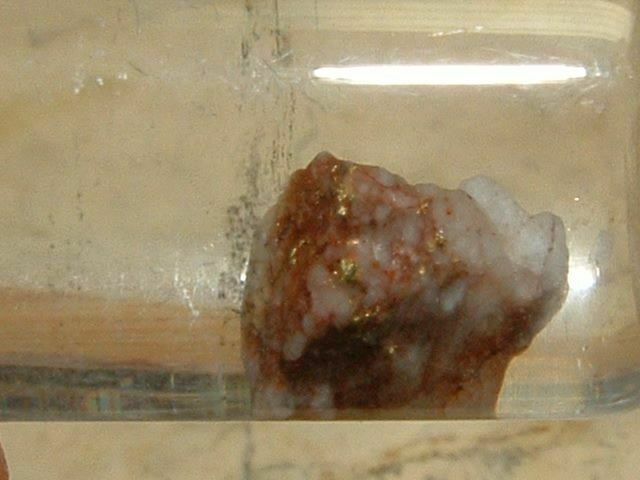-40%
RED GOLD QUARTZ SPECIMEN .34 GRAMS NATURAL GOLD AND QUARTZ
$ 12.14
- Description
- Size Guide
Description
NATIVE GOLD QUARTZ SPECIMENfrom the
MOTHER LODE
R
uler
is
1/4"
wide (6 mm). U.S. 10 cent coin is 17 mm in diameter.
S
pecimen weight:
5.2
G
rains (Troy) -
.34
G
ram
S
ize:
8.1X6.9X5.1
mm
C
heck out this piece of white and burgundy gold ore found in the Sierra Nevada Mtns. It's not large, however, one corner of the rock shows a sizable zone of gold. The interesting colors contained inside the host quartz makes a person think twice about the drab nature of gold ores. I guarantee what looks like gold is gold. It's not pure 24K gold because virtually all gold found in nature is an alloy of metals, generally, gold, silver, and copper. Judging by the golden color of the precious metal contained, the purity is quite high. I only sell naturally-occurring gold specimens.
Back when placer-mining was my full time trade, I dreamed of some day stumbling on a wash full of specimen like this. Much to my chagrin, I never did. I found nice nuggets, pockets, and paystreaks in a lot of washes, but very little placer gold uncovered came in the form of gold quartz. Moving ahead several years, It's been my good fortune to have acquired lots of specimens through the minerals and mining community. These, I pass on to collectors. So, there was a happy ending to my story about the gold I didn't find after all. All my specimens show visible gold and are
authentic
.
U.S. SHIPPING .50
(includes USPS tracking to all U.S. destinations)
INTERNATIONAL CUSTOMERS S&H
.50
FAST REFUND OFFERED
(If, for any reason, you're not happy with this item). Contact me indicating you wish to return the item. As soon as it's received by me and everything's as it should be, you'll be issued a refund.
I poured through old mining dumps for years looking at orange-yellow-rusty rock through a loupe, but I never found a piece with visible gold.
Hydrothermal solutions carrying gold and silica crystallized into veins of gold quartz. This specimen comes from one of the many vein systems sourcing the immense placer deposits of the Sierra Nevada Mtns, the famed Mother Lode.
Weight Conversions:
15.43 GRAINS = 1 GRAM
31.103 GRAMS = 1 TROY OUNCE
24 GRAINS = 1 PENNYWEIGHT (DWT)
20 DWT = 1 TROY OUNCE
480 GRAINS = 1 TROY OUNCE
S&H
Discounted for combined shipments.
PAYMENTS
For U.S. buyers: We accept paypal
For intnl. customers: We accept paypal.
Pay securely with
www.paypal
.
Payment must be made within 7 days from close of auction. We ship as soon as funds clear. If you have questions, please ask them before bidding.
REFUNDS
We leave no stones un-turned insuring our customers get what they bargained for.
If you're not satisfied with this item, contact me. Then, if the problem can't be fixed, return product within 30 days in 'as purchased' condition for a full refund
QUARTZ MINING
Californians were fortunate in that most of their gold ores were what is known as "free-milling"; that is, after the rock had been crushed so as to free the gold, the latter would amalgamate readily with quicksilver. There were some exceptions. Mill men discovered that a small percentage of the gold was enclosed within various forms of metallic sulphides colloquially known as 'sulphurets.' Mercury could not come into contact with the gold so long as the ore was locked within the sulphides. To the men of that day it seemed that mere mechanical treatment of the ore was not sufficient to release the gold, and that therefore chemistry and metallurgy would have to be used before progress could be achieved. This was too complex a problem for the average California mill operator of the 1850s and since the loss through sulphurets was relatively small, he was able to thrust it out of his mind for the time being.
Excerpt from
MINING FRONTIERS OF THE FAR WEST 1848-1880
by Rodman Wilson Paul
GREEN GOLD
Placer platinum, a rare, even more exotic metal than gold, is found in North America; one of the more impressive deposits being British Columbia's Tulameen River and it's tributaries. Trinity County, California also can boast of considerable production in Platinum Group Metals as does the northwest coast of Alaska, especially the Good News Bay region. Historians delving into early North American platinum discoveries (i.e. the 1800s) note that gold miners recovered heavy, silver-grey metal in their sluice boxes and were at a loss to identify this raw, metallic-looking element. Lacking the wealth of mineralogical knowledge available today, they deduced it must be 'green gold'. Since it was heavy like gold and looked somewhat like gold, they figured it simply hadn't ripened enough to be valuable and threw it away.
Having mined PGMs (platinum group metals), some of which were difficult to identify, I've no trouble believing this story about British Columbia miners. One unusual matrix nugget I found weighed 43 grain. It was recovered from a dredging operation on the Trinity River, California. After being stashed away for 20 years never knowing exactly what it was, eventually, thanks to a customer, I was to learn it indeed was platinum (Pt) in a Dunite host. You just don't find platinum with matrix and yet here I had accidentally found one. A major problem with going back in to mine some of these deposits is that they don't really allow mechanized placer-mining in California any more.
Thanks for checking out our diggins'
G
old of
E
ldorado
10-11-18















